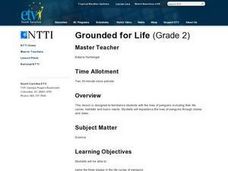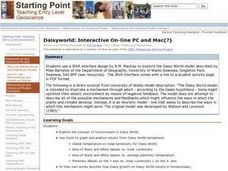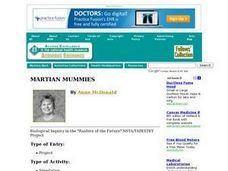Curated OER
Ecological Inventory
Students brainstorm possible life forms and chemical composition of surrounding water environments. They research background information through internet and library resources.
Curated OER
BACKYARD SAFARI - BUTTERFLIES
Young scholars investigate the life cycle of a butterfly. They visit a butterfly expert who teaches her about the "tricks" caterpillars use to fool their enemies, the functions of the parts of a butterfly, and how to tag a butterfly.
Curated OER
Termite trails
Students observe termite trail-following behavior. Termites tend to follow lines made on paper by ballpoint pens because the ink contains a chemical that is similar to the trail pheromones used by termites to lead colony members to food...
Curated OER
"Did You Eat That!"
First graders investigate why plants are an important part of our everyday lives, providing us with food, clothing, shelter, etc. In this lesson students participate in a series of hands-on, online, and multimedia activities to examine...
Curated OER
Grounded for Life
Second graders become familiar with the lives of penguins including their life cycles, habitats and basic needs. Students will experience the lives of penguins through stories and video.
Curated OER
Eye Spy
Fourth graders examine how the human eye receives and transmits light from the environment. Through an activity, the students will discuss the importance of sight in our everyday lives.
Curated OER
Owl Pellets: A Fowl-Up, Chuck!
Students discover the world of owls as predators. After watching a video of owls hunting and eating, are introduced to owl pellets. Students dissect their own pellet and match the prey's bones to a bone diagram.
Curated OER
Wh0-o-o-o's Out There?
Fifth graders describe the physical features of an owl and identify survival adaptations. They Investigate an owl's niche in an ecosystem. The students participate in an interactive puzzle on the internet that helps for motivation.
Curated OER
Dissolved Oxygen Lesson
Students investigate what dissolved oxygen is and why it is important to aquatic life and what factors influence levels of dissolved oxygen in a lake. They study how to use MS Excel to make charts to show trends and correlations.
Curated OER
Adopt-An-Insect Project
Students create a school-wide insect collection investigate the insect world. For this project, each grade level "adopts" specific orders of insects, collect specimens, create classroom collections, and complete related activities.
Curated OER
Birds of Different Feathers: Species Specialization
Learners identify differences in bird species and explain the concept of species specialization. They attain the knowledge that different birds occupy different habitats.
Students identify characteristics and features of birds that make...
Curated OER
Wetland Ecosystem Conservation
High schoolers read articles about wetland ecosystem conservation in Florida and other countries. They summarize information found in the articles. Students reflect on the information in the articles and write their feelings.
Curated OER
Ecosystem Relationships
Students study the relationship between the types of trees, soil, and organisms. They investigate the complex interactions and cycles at work in the forest and understand the factors that contribute to a healthy, sustainable forest.
Curated OER
Daisyworld: Interactive On-line PC and Mac
Students use a JAVA interface to explore the Daisy World model to illustrate a mechanism through which - according to the Gaian hypothesis - biota might optimize their abiotic environment by means of negative feedback.
Curated OER
Biology Tessellations
Students review three types of polygons that are triangles, squares, and hexagons. They use a computer program to draw various types of tessellations. The students use the drawing of a honeybee as inspiration.
Curated OER
Rain Forest Project
Students recognize the relationships among the various parts of the world's environment. They practice the concepts of ecology and ecology. The importance of recycling and the complexities of world politics is also taught.
Curated OER
Active Ingredient Screening Test for Plants
Students explore the growth of bacteria. They determine if various plant materials contain active ingredients that inhibit the growth of bacteria. In addition, they complete a student data sheet.
Curated OER
Creative Ways To Teach Evolutionary Concepts
Students explore evolutionary concepts in cartoons and lab activities. They describe and explain evolutionary concepts featured in a cartoon and participate in laboratory activities.
Curated OER
Plant Biotechnology: Controlling Tissue Differentiation
Students demonstrate hormonal control of plant tissue differentiation and relate this differentiation to gene expression. They explore the effects of hormones (auxin and cytokinin) on the genes that control tissue differentiation in callus.
Curated OER
The Opposable Thumb
Young scholars explore the physical importance of the opposable thumb among primates. They discover which of their simplest daily activities are possible only because of their opposable thumbs.
Curated OER
Using A Winogradsky Column to Analyze Microbial Communities
Students use easily obtained materials to study ecological succession in a microbiological community. They collect water samples from outdoor sources in plastic bottles to observe and record changes.
Curated OER
Separating a Starch-Glucose Mixture Using Gel Filtration
Students experiment using the basic principles of gel filtration. They use the gel filtration technique for testing for the presence of specific substances. Students discover that starch is a larger molecule than glucose.
Curated OER
Job Hiring...Who's the best candidate?
Students, working in teams, assume they are the newly hired research director of a biotech firm interviewing the top two candidates for the position of research scientist. They evaluate the candidates and decide who should be hired based...
Curated OER
Martian Mummies
Learners participate in "Raiders of the Future", a role play about futuristic scientists sending a spaceship to Mars for research and exploration. They collect geological samples for analysis, discover the ruins of an ancient...

























